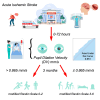Automated pupillometry is a predictor of outcome of stroke patients: an observational, prospective, cohort study
- PMID: 40040840
- PMCID: PMC11878543
- DOI: 10.1093/braincomms/fcaf079
Automated pupillometry is a predictor of outcome of stroke patients: an observational, prospective, cohort study
Abstract
Automated pupillometry (AP) is a rapid, non-invasive tool to assess the pupillary light reflex, extensively used for monitoring patients with traumatic brain injury. In acute ischaemic stroke, quantitative tools to monitor neurological status and predict outcome are lacking. This study aims to evaluate the ability of AP to predict stroke outcome, defined through the modified Rankin Scale (mRS) scores. In this observational, cohort study, we enrolled adult patients with anterior circulation stroke admitted to the stroke unit of a comprehensive stroke centre between 2021 and 2024 who underwent AP evaluation within 72 h of stroke onset. Exclusion criteria were: intracranial hypertension, severe eye diseases, pathologies involving the autonomic nervous system and lack of 3-month follow-up data. The AP evaluation was repeated three consecutive times in each patient using the NPi-200® and mean parameters of the two eyes and those of the eye homolateral and contralateral to the ischaemic lesion were considered. Mann-Whitney U-test, t-test and χ 2-test were used for univariate comparisons. Binary and ordinal multivariable logistic regression models were used for the adjusted analysis. The primary outcome measure was the dichotomization of the 3-month mRS of 0-2 versus 3-6. Secondary outcomes were the score on the 3-month mRS, 3-month dichotomization of mRS 0-3 versus 4-6, and 3-month and in-hospital death. Receiver operating characteristic curves (ROC) were computed to evaluate the prognostic ability of AP. Two-hundred and nine patients (123 men, median age 75 years) were included in the study. Among included patients, 11 (5.3%) died during the hospital stay and 124 (59.33%) had a 3-month mRS < 3. In multivariable logistic regression models corrected for all possible confounders, a low dilatation velocity (DV) in the eye homolateral to the stroke lesion was an independent predictor of poor prognosis, defined as both mRS > 2 and mRS > 3 at 3 months (P = 0.028 and P = 0.024, respectively). Furthermore, homolateral DV resulted to be a significant predictor of a shift towards a better outcome on the 3-month mRS in the ordinal logistic regression (P = 0.036). A DV ≥ 0.865 mm/s was able to predict a good stroke outcome at 90 days with 60% sensitivity and specificity (area under the curve 0.651; P < 0.001). No other AP parameters were independent predictors of stroke outcome. A reduction in the DV in the eye ipsilateral to the ischaemic lesion is associated with poor in-hospital and 3-month stroke outcome, and it could be useful for identifying patients who need a tailored monitoring and treatment path to improve their prognosis.
Keywords: NeurOptics; automated pupillometry; dilation velocity; pupillary light reflex; stroke outcome.
© The Author(s) 2025. Published by Oxford University Press on behalf of the Guarantors of Brain.
Conflict of interest statement
The authors declare no competing interests.
Figures




References
-
- Bouffard MA. The pupil. Continuum (Minneap Minn). 2019;25(5):1194–1214. - PubMed
-
- Sharshar T, Citerio G, Andrews PJ, et al. Neurological examination of critically ill patients: A pragmatic approach. Report of an ESICM expert panel. Intensive Care Med. 2014;40(4):484–495. - PubMed
-
- Ritter AM, Muizelaar JP, Barnes T, et al. Brain stem blood flow, pupillary response, and outcome in patients with severe head injuries. Neurosurgery. 1999;44(5):941–948. - PubMed
-
- Olson DM, Stutzman S, Saju C, Wilson M, Zhao W, Aiyagari V. Interrater reliability of pupillary assessments. Neurocrit Care. 2016;24(2):251–257. - PubMed
LinkOut - more resources
Full Text Sources
